Televisions: One Season in American Television
By Marc Eliot
Published in 1983
Published by St. Martin’s Press
179 Pages
I picked up a copy of this book at a used bookstore several years ago. Sadly, that bookstore has since closed. But I still have my hardcover copy of Marc Eliot’s Televisions: One Season in American Television, published in 1983. It’s a fascinating analysis of the 1981-1982 television season in the United States of America which involves a strike, the coming of cable, Jerry Falwell’s Moral Majority and more. Eliot focuses heavily on Nielsen ratings, which are always interesting, and also interviews producer Garry Marshall.
In his prologue, Eliot explains that every so often a television season comes long that is defined by a single program. Or, perhaps, by a newsworthy real-world event. Of the 1981-1982 season, Eliot writes that it was “dominated by off-screen, unscheduled events and issues–political, social, economic.” He explains that politically, the season was defined by strikes; socially, it was the Moral Majority; and economically it was the expansion of cable.
Eliot devotes two chapters to the Moral Majority, four to television ratings, one to cable, one to drugs, one to independent production and two to miscellaneous items. He introduces the Moral Majority and the Coalition of Better Television with its boycotts of programs unsuitable for children due to violence or sexual content. M*A*S*H, The White Shadow, Flo and Soap were among the shows criticized for vulgar language while Happy Days, Too Close for Comfort and Three’s Company were some of the shows that were too sexual.
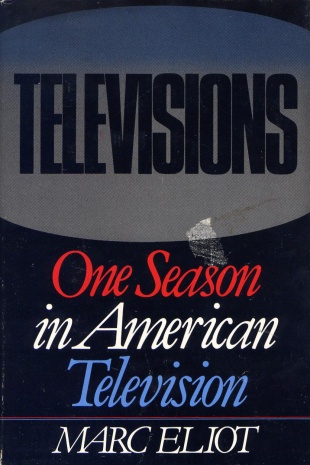
Televisions: One Season in American Television – Copyright 1983 St. Martin’s Press
A proposed boycott never came to fruition but sponsors pulled out nonetheless. Eliot also discusses Ed Asner’s political inclinations and his involvement in the 1981 writers strike, plus the cancellation of Lou Grant. There’s a chapter on television news and a few pages on daytime talk shows. But by far my favorite part of the book are the chapters analyzing Nielsen ratings. He briefly introduces the ratings, then talks about the November sweeps period, and provides the complete ratings for the week ending Sunday, November 8th).
Perhaps the most intriguing portion of the book involves a comparison between the first half of the 1981-1982 season with the 1980-1981 season. Dallas, for example, was down from a 31.8 Nielsen rating to a 28.1 rating. The Dukes of Hazzard fell from a 25.2 to a 21.8, The Love Boat from a 24.1 to a 21.0 and House Calls from a 22.3 to a 19.5. On the other hand, 60 Minutes grew from a 26.8 rating during the 1980-1981 season to a 27.6 rating during the first half of the 1981-1982 season.
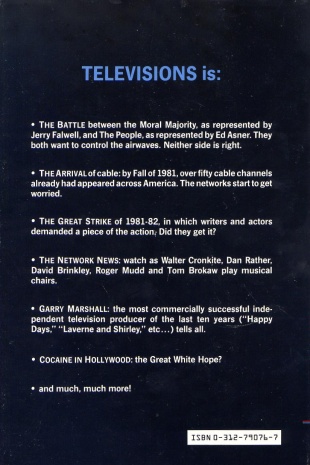
Televisions: One Season in American Television – Copyright 1983 St. Martin’s Press
Finally, Eliot provides the complete rankings for the 1981-1982 season as a whole. NBC’s Fitz and Bones was dead last at 105th with a 8.7 rating. ABC’s Police Squad was 57th with a 15.5 rating. NBC’s Q.E.D. tied for 98th with a 10.1 rating. He discusses how the networks were disturbed by the way teenagers were drifting away from broadcast television (that sounds familiar, doesn’t it).
The interview with Garry Marshall covers all manner of topics: the Moral Majority, censorship, ratings, strikes, quality, cable, time slots, older viewers and more. Another interview, with a group of network executives who wished to remain nameless, discusses the cost of a pilot, the Moral Majority, whether or not Hill Street Blues can succeed, how much authority writers have and the trend of making television shows out of movies.
All told, Televisions: One Season in American Television is a great read. I only wish Eliot had continued writing such books for later seasons or, better yet, earlier ones. It’s out of print but you should be able to find a used copy online.

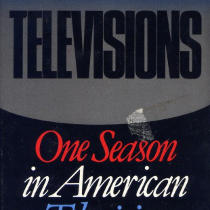
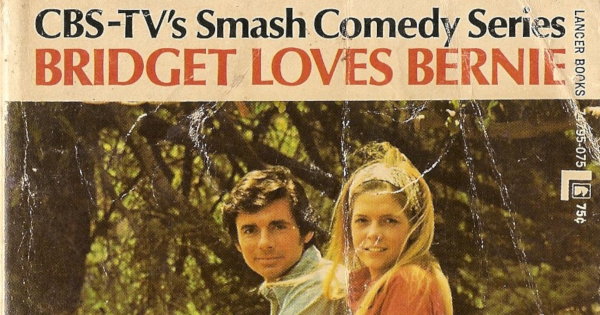
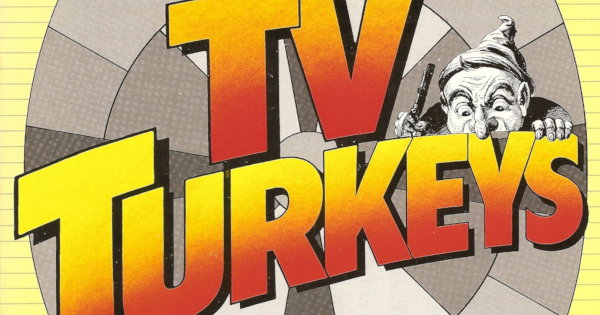
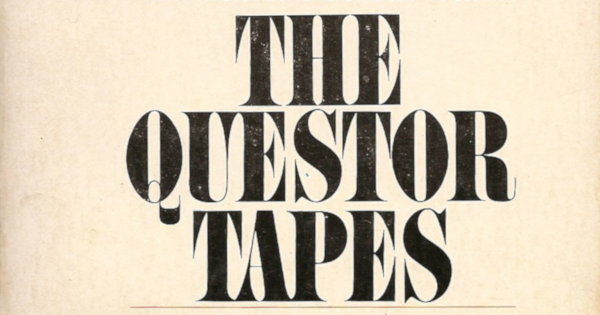



“HILL STREET BLUES” DID succeed, but it took two seasons for it to become a “hit”. “FLO” was cancelled after its second season, in the spring of 1982 (poor ratings on Mondays opposite “LITTLE HOUSE ON THE PRARIE” and “THAT’S INCREDIBLE!”, not the “Moral Majority”, did it in). “Q.E.D” was a CBS series, and it only lasted six weeks that spring, because that’s how many episodes were ordered (I KNEW it wasn’t to be around longer). There were a LOT of “six episode wonders” that season– including Gary David Goldberg’s “MAKING THE GRADE”, the series he produced for Paramount {and CBS} that spring of ’82 before he gained an annuity with “FAMILY TIES” on NBC that fall (he eventually reworked “MAKING THE GRADE” into the hour-long NBC drama “THE BRONX ZOO” a few years later, with not much success), and co-star George Wendt got his with NBC’s “CHEERS” that fall. Garry Marshall’s “empire” was about to collapse, with the feud between Penny Marshall and Cindy Williams on “LAVERNE & SHIRLEY” (which became, in essence, “THE LAVERNE SHOW” in the fall of ’82 when Cindy abruptly left the show), the cancellation of “MORK & MINDY” {WHY did they stop filming before a live audience??}, and that…”JOANIE LOVES CHACHI”, eccch!
“HOUSE CALLS” ended because Lynn Redgrave was “forced” out of the series, and Sharon Gless [Universal’s last “contract player” on their roster] replaced her for the last 13 episodes- by then, it had become “Wayne Rogers’ show”, and the ratings finally did it in. This was probably the best thing that could have happened to her, because she began “CAGNEY & LACEY” the following season, which replaced “LOU GRANT” (which really couldn’t survive in the “Age Of Reagan”).
“POLICE SQUAD!” was another “six episode wonder” in the spring of 1982 that was NEVER going to be renewed because, no matter HOW funny it was, it was “too weird” for a mass audience. ABC wanted more sitcoms along the lines of “HAPPY DAYS” and “THREE’S COMPANY”. They didn’t even want “TAXI” anymore, pushing it off their schedule in 1982, with NBC getting it for one more season, after HBO almost did; “BARNEY MILLER” had run its course as well. CBS sabotaged “WKRP IN CINCINNATI” by moving it into too many different time periods and evenings- they just didn’t WANT it on their schedule any more.
“M*A*S*H” would have ended after the 1981-’82 season, but CBS needed it to “prop up” its sagging Monday night schedule (so few successes), so everyone was talked into “enlisiting” for ONE MORE SEASON. “THE DUKLES OF HAZZARD” continued, but John Schneider and Tom Wopat walked away from the show after the 1981-’82 season simply because they wanted more dough. Their “look-alike” replacements for the fall of ’82 just weren’t popular with fans, and the “real Dukes” returned before the season was over; CBS insisted on their return partly because their wanted to make sure their investment in the Saturday morning animated version of the show, “THE DUKES” (which premiered in January 1983) wouldn’t be “wasted”. It was, as the cartoon was quietly dropped before the end of the 1983-’84 season.
My family began subscribing to cable in the spring of 1981…a limited number of channels at first, but I could see the changes coming…